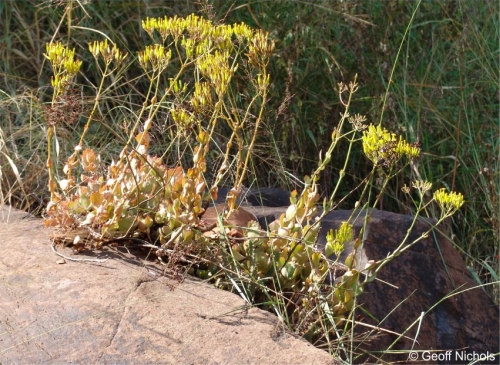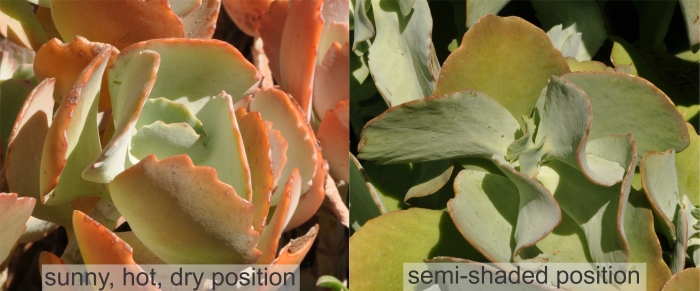Kalanchoe longiflora
Kalanchoe longiflora Schltr. ex J.M.Wood
Family: Crassulaceae
Common names: Tugela cliff-kalanchoe, long-flower kalanchoe (Eng.); Tugela kransplakkie (Afr.)
Introduction
Kalanchoe longiflora is a little-known succulent shrub with attractive multi-hued foliage and yellow flowers in autumn to winter. It is suitable for containers, rock gardens, retaining walls and water-wise or arid gardens.

Description
Description
A sparse shrublet up to 400 mm high with branches that lie along the ground with the tips growing upward (decumbent). The roots are fibrous. Branches are quadrangular (cut ends are square) and fleshy but woody towards the base of the plant. Leaves are fleshy, and shaped like a limpet shell (patelliform), the tip of the leaf is rounded and has rounded teeth, and the base is wedge-shaped, 40-80×30-80 mm. The leaves are an attractive light bluish grey-green, covered in a waxy bloom and the edges and older leaves are flushed pinkish to reddish brown. Flowers are yellow and made up of four petals fused into an elongated tube 11-14mm long, with spreading, narrowly triangular lobes 2-3mm long. The flowers are arranged in a rounded, loosely branched inflorescence. The Kirstenbosch plants flower from autumn to winter (May-June).

Kalanchoe longiflora can be confused with the closely related K. sexangularis , but it can be distinguished by its four-angled stems, grey patelliform leaves, and it has a longer corolla tube, whereas Kalanchoe sexangularis stems are cylindrical to irregularly ridged, and its corolla tube is 7-10 mm long.

Conservation Status
Status
Vulnerable. Kalanchoe longiflora is rare and poorly known. It is currently known from less than five locations which are close to densely populated areas which damage and degrade the surrounding natural areas, due to activities such as grazing, trampling and agriculture. However, the fact that this species prefers rocky sites protects it from most damage caused by humans. Its population is stable.
Distribution and habitat
Distribution description
Kalanchoe longiflora is a cliff-dweller (cremnophyte), found on rock faces and shale slopes, at 800-1700m altitude, in the central Tugela catchment basin, from Tugela Ferry to Muden, in KwaZulu-Natal. There are records of it occurring outside of this area; however, these specimens have most probably been misidentified and are possibly K. sexangularis.

Derivation of name and historical aspects
History
The genus Kalanchoe is named from the Chinese name for one of the species. This species is named for its long corolla tubes, longiflora meaning 'long flowered', from the Latin longus meaning long, and floreo flower.
There are ±200 species of Kalanchoe found in tropical Africa, Madagascar, southern and southeastern Asia and northern Australia. There are 13 species in southern Africa, where they are found only in the summer rainfall area, excluding most of the Karoo, Western Cape, Eastern Cape and southern Namibia.
Ecology
Ecology
Kalanchoe longiflora branches snap and break if knocked roughly, and the broken-off pieces of stem that fall to the ground root readily if they fall on soil. This is an adaptation to survive trampling by animals, or damage by rock falls. Plants growing in full sun develop reddish pink colours in the leaves.

Uses
Use
Kalanchoe longiflora is not known to be used in traditional medicine although other species are, e.g. K. paniculata (rabbit's ear) is used as a charm, K. rotundifolia (common kalanchoe) is used as an emetic and K. thyrsiflora (white lady) is used as a charm, as an anthelmintic enema and to treat earache. Also, many kalanchoes are poisonous to grazing animals such as cows, sheep and goats, causing botulism-like symptoms and haemorrhagic diarrhoea.

Growing Kalanchoe longiflora
Grow
Grow Kalanchoe longiflora in well-drained soil in a position that gets full sun. Plants grown in a cooler, shadier spot will not show the reddish colouration of the leaf tips as strongly, and also tend to have larger leaves. Regular watering and feeding with compost will produce larger, healthier, faster-growing plants.
Kalanchoe longiflora is a tough, heat- and drought-tolerant plant that is ideally suited to rockeries and retaining walls. It is also suitable for the water-wise garden or the arid garden and for containers. Planted en masse it is an excellent groundcover and edging plant. Planted in smaller groups, its unusual light-coloured foliage can be used to create contrast, or a point of interest in a mixed border or shrubbery.
Kalanchoe longiflora is easily propagated by cuttings; pieces of stem can be planted straight in the soil in a cold frame or directly in the garden and will root without the need of rooting hormone or mist. Because cuttings are so easy to root, we have not propagated this plant from seed at Kirstenbosch National Botanical Garden.
References
- Hutchings, A. 1996. Zulu Medicinal Plants, an inventory . University of Natal Press, Pietermaritzburg.
- Jackson, W.P.U. 1990. Origins and Meanings of Names of South African Plant Genera . UCT Printing Department, Cape Town.
- Leistner, O.A. (ed.). 2000. Seed plants of southern Africa: families and genera. Strelitzia 10. National Botanical Institute, Pretoria.
- Plants of southern Africa online, http://posa.sanbi.org. Accessed 2014/04/30.
- Tolken, H R, Leistner O E . 1985. Flora of Southern Africa Vol 14. Crassulaceae. Dept of Agric. Water Supply, Pretoria.
- Von Staden, L. & Dayaram, A. 2011. Kalanchoe longiflora Schltr. ex J.M.Wood. National Assessment: Red List of South African Plants version 2013.1. Accessed on 2014/04/30.
Credits
Alice Notten
Kirstenbosch National Botanical Garden
May 2014
Plant Attributes:
Plant Type: Ground Cover, Shrub, Succulent
SA Distribution: KwaZulu-Natal
Soil type: Sandy, Loam
Flowering season: Autumn, Winter
PH:
Flower colour: Yellow
Aspect: Full Sun, Morning Sun (Semi Shade), Afternoon Sun (Semi Shade)
Gardening skill: Easy
Special Features:
Horticultural zones











Rate this article
Article well written and informative
Rate this plant
Is this an interesting plant?
Login to add your Comment
Back to topNot registered yet? Click here to register.